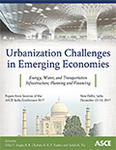ASCE India Conference 2017
Hydrothermal Pretreatment of Tender Coconut Coir and Optimization of Process Parameters Using Response Surface Methodology
Publication: Urbanization Challenges in Emerging Economies: Energy and Water Infrastructure; Transportation Infrastructure; and Planning and Financing
ABSTRACT
India is the leading country in the production of coir contributing about 60% of the world’s production. This study focusses on recovery of reducing sugars from tender coir using hot water pretreatment method. For pretreatment, three independent factors—biomass (X1, mg/ml), time (X2, min), and temperature, (X3, °C) and one dependent factor—reducing sugar (Yrs, %), were considered. ANOVA and optimization were done using Statistica, a statistical software. The second order model obtained after multiple regression analysis was found to be significant since the model p-value was less than 0.05. The coefficient of determination (R2) was 0.97 and adjusted R2 was 0.95. It was predicted that 34% reducing sugar per gram of coir could be recovered when 32.8 mg/ml biomass was pretreated for 58 mins at 173 °C. The prediction was later experimentally verified.
Get full access to this article
View all available purchase options and get full access to this chapter.
ACKNOWLEDGEMENT
This research was funded by Ministry of Human Resource and Development, Government of India, under FAST program
REFERENCES
Amarasekara, A. S. (2013). Handbook of cellulosic ethanol. John Wiley & Sons.
Arnold, S. F. (2006). Design of Experiments with MINITAB. The American Statistician.
Cheng, K. K., Cai, B. Y., Zhang, J. A., Ling, H. Z., Zhou, Y. J., Ge, J. P., and Xu, J. M. (2008). “Sugarcane bagasse hemicellulose hydrolysate for ethanol production by acid recovery process.” Biochemical Engineering Journal, 38(1), 105-109.
Dubois, M., Gilles, K. A., Hamilton, J. K., Rebers, P. A., and Smith, F. (1956). “Colorimetric method for determination of sugars and related substances.” Analytical Chemistry, 28(3), 350-356.
Goering, H. K., and Van Soest, P. J. (1970). Forage fiber analyses (apparatus, Reagents, Procedures, and Some Applications). USDA Agriculture Handbook No. 379.
Gundupalli, M. P., and Bhattacharyya, D. (2017). “Recovery of Reducing Sugar from Food Waste: Optimization of Pretreatment Parameters Using Response Surface Methodology.” Biofuels and Bioenergy (BICE2016): International Conference, Bhopal, India, 23-25 February 2016, S. Suresh, A. Kumar, A. Shukla, R. Singh, and C. M. Krishna, eds., Springer International Publishing, Cham, 161-172.
Gundupalli, M P., Bhattacharyya, D. (2017). “Dilute Sulphuric Acid Hydrolysis of Coconut Coir: Process Optimization for Recovery of Reducing Sugar - The IAFOR Research Archive.” <https://papers.iafor.org/submission36959/>.
R.H. Myers, D.C. Montgomery, and C.M. Anderson-Cook, (2016). Response Surface Methodology: Process and Product Optimization Using Designed Experiments. WILEY SERIES IN PROBABILITY AND STATISTICS Established.
Harmsen, P., Huijgen, W., López, L., and Bakker, R. (2010). “Literature Review of Physical and Chemical Pretreatment Processes for Lignocellulosic Biomass.” Food and Biobased Research, (September), 1-49.
Khalil, H. P. S. A., Alwani, M. S., and Omar, A. K. M. (2007). “Chemical composition, anatomy, lignin distribution, and cell wall structure of Malaysian plant waste fibers.” BioResources, 1(2), 220-232.
Lee, H. V., Hamid, S. B. A., and Zain, S. K. (2014). “Conversion of lignocellulosic biomass to nanocellulose: Structure and chemical process.” Scientific World Journal, 2014.
Li, H., Chen, X., Ren, J., Deng, H., Peng, F., and Sun, R. (2015). “Functional relationship of furfural yields and the hemicellulose-derived sugars in the hydrolysates from corncob by microwave-assisted hydrothermal pretreatment.” Biotechnology for Biofuels, 8(1), 127.
Lü, J., and Zhou, P. (2016). “Ethanol Production from Microwave-Assisted FeCl 3Pretreated Rice Straw Using Free and Immobilized Cells of Trichoderma viride and Sacharomyces cerevisiae.” Journal of Energy Engineering.
Luo, C., Brink, D. L., and Blanch, H. W. (2002). “Identification of potential fermentation inhibitors in conversion of hybrid poplar hydrolyzate to ethanol.” Biomass and Bioenergy, 22(2), 125-138.
Miller, G. L. (1959). “Use of Dinitrosalicylic Acid Reagent for Determination of Reducing Sugar.” Analytical Chemistry, 31(3), 426-428.
Montgomery, D. C. (2001). “Design and Analysis of Experiments.” Design, 2(653), 780 ST-Design and analysis of experiments. Adva.
Montgomery, D. C., and Myers, R. H. (1995). “Response surface methodology: process and product optimization using designed experiments.” Raymond H. Meyers and Douglas C. Montgomery. A Wiley-Interscience Publications.
Muensri, P., Kunanopparat, T., Menut, P., and Siriwattanayotin, S. (2011). “Effect of lignin removal on the properties of coconut coir fiber/wheat gluten biocomposite.” Composites Part A: Applied Science and Manufacturing, 42(2), 173-179.
Ruiz, R., Scarlata, C., Sluiter, J., Templeton, D., and Crocker, D. (2011). “Determination of Structural Carbohydrates and Lignin in Biomass.” National Renewable Energy Laboratory Technical Report NREL/.
Sindhu, R., Binod, P., and Pandey, A. (2016). “Biological pretreatment of lignocellulosic biomass-An overview.” Bioresource technology.
Tian, S. Q., Wang, X. W., Zhao, R. Y., and Ma, S. (2016). “Effect of doping pretreated corn stover conditions on yield of bioethanol in immobilized cell systems.” Renewable Energy, 86, 858-865.
Xing, L., Wu, Z., and Gong, G. (2014). “Dissolution of Cotton Cellulose with Ionic Liquids 1-Butyl-3-Methylimidazolium Chloride and 1-Allyl-3-Methylimidazolium Chloride to Prepare Reducing Sugar.” Journal of Energy Engineering, 140(2), 4013013.
Information & Authors
Information
Published In
Urbanization Challenges in Emerging Economies: Energy and Water Infrastructure; Transportation Infrastructure; and Planning and Financing
Pages: 178 - 188
Editors: Udai P. Singh, B. R. Chahar, Indian Institute of Technology, H. R. P. Yadav, Institution of Engineers (India), and Satish K. Vij
ISBN (Online): 978-0-7844-8202-5
Copyright
© 2018 American Society of Civil Engineers.
History
Published online: Dec 13, 2018
Authors
Metrics & Citations
Metrics
Citations
Download citation
If you have the appropriate software installed, you can download article citation data to the citation manager of your choice. Simply select your manager software from the list below and click Download.
